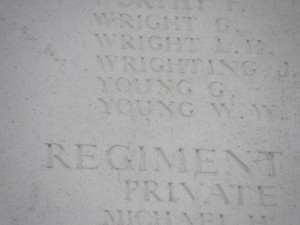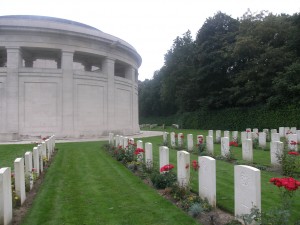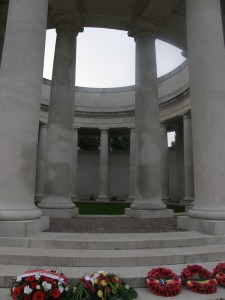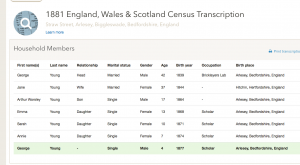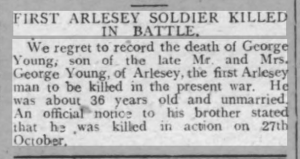George Young
Name: George Young
1877 - 27th October 1914
Place of Birth: Hitchin
Occupation: Brickmaker
Division: 3rd Battalion
Regiment: Rifle Brigade (The Prince Consort's Own)
Rank: Rifleman
Buried: Panel 10, Ploegsteert Memorial, Comines-Warneton, Hainau, Belgium
Person(s) placing the cross on behalf of the Arlesey Remembers You Project: Sandra & Jamie Sarll
George was born in Arlesey in 1877, the youngest son of George and Jane Young. George had an older brother, Arthur born in 1864, and three sisters; Emma born in 1868, Sarah born in 1871 and Annie born in 1874. At the time of the 1881 census the family were living in Straw Street, Arlesey, and George Snr was employed as a brickyard labourer.
On the 9th July 1896, George was attested into the 3rd Battalion of the Bedfordshire Regiment. His service records tell us he was 18 years and 10 months old and was employed as a brick maker by Messrs Beart. He was living on Hitchin Road, Arlesey and was single. He had previously been rejected as unfit for service by the Army for being underweight. He gave his height as 5 feet 5 inches and weighed 112lbs. He had a freckled complexion, brown hair and brown eyes. He joined the army for 49-day service before later enlisting in the reserves on 9th June 1899 and then the Rifle Brigade on 12th December 1899. At the time of enlisting for the Reserves George was living at Box Tree Cottage, Arlesey, apparently with his sister, Sarah (who had married Thomas Matthew in 1899). He gave his next of kin as his brother, Arthur Worlsey Young, of Hitchin Road, Arlesey.
George died on 27th October 1914, the first Arlesey man to die in the war. At the time of his death he was in the 3rd Battalion of the Rifle Brigade, while with the British Expeditionary Force (BEF). The 3rd Battalion was part of the 3rd Corps of the BEF, forming the 6th Division along with the 16th (Inf) Brigade, 1st Btn Kings Shropshire Light Infantry and 18th (Inf) Brigade, 2nd Btn Durham Light Infantry, who landed in France on 8th/9th September 1914. In late September the BEF were transferred from the Aisne region to Flanders to unify British Forces on the continent, to shorten the British lines of communication from England and to defend Antwerp and the Channel Ports. On the night of the 1st/2nd October the transfer of the BEF began in great secrecy. Marches were made at night and billet troops were not allowed to venture outside during daylight. 3rd Corps began to assemble around Saint Omer and Hasbrouck on October 11th, where they then moved behind the flanks of 2nd Corps.
There is no record of which battle George was killed in. He is remembered with honour at Ploegsteert Memorial, which is located 12.5Km south of Ieper town centre. The memorial commemorates more than 11,000 servicemen of the UK and South African Forces who died in this region and have no known grave. Most of those commemorated did not die in major offensives but in the course of day-to-day trench warfare or in small scale set engagements, usually carried out in support of major attacks somewhere else.



